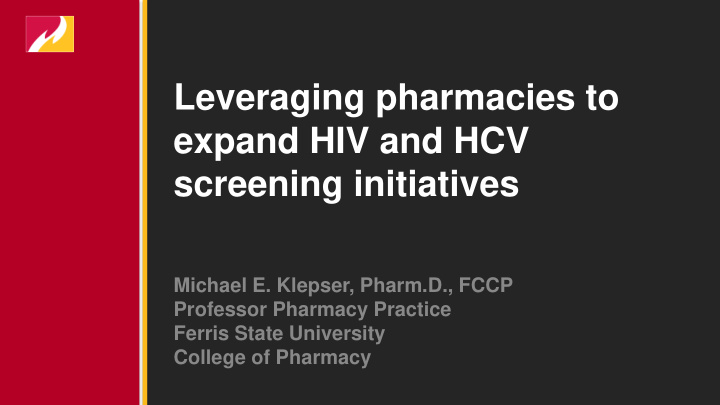



Leveraging pharmacies to expand HIV and HCV screening initiatives Michael E. Klepser, Pharm.D., FCCP Professor Pharmacy Practice Ferris State University College of Pharmacy
Disclosure Statement of Financial Interest I, Michael Klepser, DO have a financial interest/arrangement or affiliation with one or more organizations that could be perceived as a real or apparent conflict of interest in the context of the subject of this presentation, they are: Affiliation/Financial Interest: Name of Organization (s): Grant/Research Support: National Association of Chain Drug Stores Foundation Roche Diagnostics Consultant: Arkray Diagnostics Speaker's Bureau: Major Stock/Shareholder : (excluding mutual funds) Advisory Board: National Association of Chain Drug Stores Foundation POCT Certificate Program
Objectives • List rationale to support pharmacy- based disease management/screening programs. • Describe outcomes associated with a pharmacy-public health collaborative HIV/HCV screen program.
The Evolving Practice of Community Pharmacy Today’s Community Pharmacist: Historically Pharmacists have: • • Compounded medications Dispenses medications • • Dispensed medications Counsels patients • • Counseled patients Administers immunizations • • Supervised technicians Provides disease management services • Supervises technicians • Compounds medications • Conducts POCT
Pharmacist Education • All pharmacists graduate with a Doctor of Pharmacy degree. – 3 years of graduate coursework plus 1 year of clinical rotations. – Trained to conduct physical assessment and collect and interpret laboratory data. • Many complete post-graduate residency training programs.
The Case for Collaborative Disease State Management • There are between 59,000-67,000 community pharmacies in the United States. – 92% of Americans live within 1.6 miles of a pharmacy • Estimated to be 13 billion pharmacy visits annually. Acute Symptomatic Medical Visits – 470 million annual physician office Medical visits. All Pharmacy Visits Visits – 530-570 visits per pharmacy each Non-Medical day. Visits Adequacy of Pharmacist Supply:2004 to 2030. Department of HHS. 2008
The Case for Collaborative Disease State Management • Pharmacists have been helping to manage patients with various medical conditions for decades. – POC tests now provide more objective data. – Data sharing barriers are eroding.
Pharmacy-Based Disease Management/Screening Programs Screening Programs Management Programs • • Cholesterol Acute pharyngitis • • Blood glucose Influenza • • Blood Lead Sexually transmitted infections (Pilot) • HIV • HCV
Percent of Pharmacies with CLIA- waivers ME Klepser, et al. Res Soc Admin Pharm. 2015.
Pharmacy-Based Management Programs • 30%-40% of patients do not identify a primary care provider • Cost-effective • Convenient • Patient satisfaction is greater than 90% • Fit into existing pharmacy workflow
Pharmacy-Based HIV/HCV Screening • Early identification and linkage to and retention in care improves the course of HIV/HCV. – Current screening efforts have been inadequate. • Millions are still unaware of their status. • 50% of reactive patients do receive treatment and are lost to follow-up. • Pharmacists and employees reflect the patient population. – Cultural, social, religious connections
Experience with HIV/HCV Screening • Partnered with >70 pharmacies in Michigan, West Virginia, and Georgia to provide screening. • Partnered with state and local health departments to establish reporting and linkage to care procedures. • Participating pharmacists received 20 hours of training related to testing and counseling. • Screening results: HIV 1.5% reactive; HCV 17% reactive – All were successfully linked to follow-up care
Summary • Pharmacists are well-positioned to partner with public health agencies to expand HIV and HCV screening efforts.
Recommend
More recommend